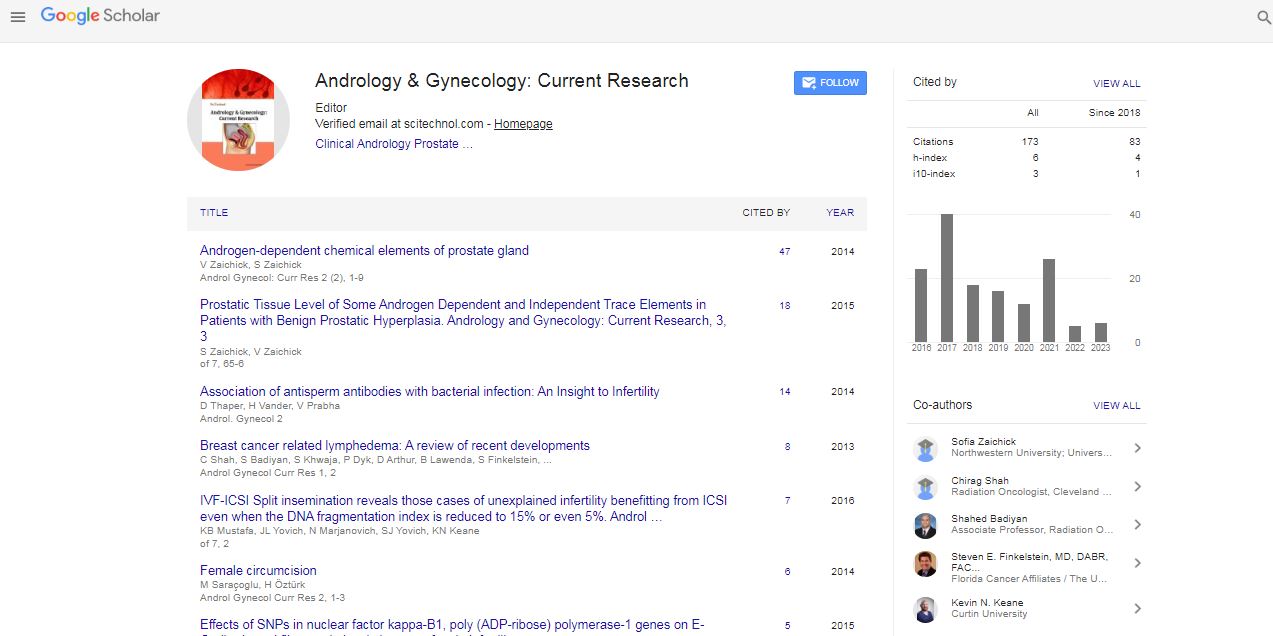Research Article, Androl Gynecol Curr Res Vol: 3 Issue: 3
Prostatic Tissue Level of some Androgen Dependent and Independent Trace Elements in Patients with Benign Prostatic Hyperplasia
| Sofia Zaichick1 and Vladimir Zaichick2* | |
| 1Department of Medicine, University of Illinois College of Medicine, Chicago,IL 60612, USA | |
| 2Radionuclide Diagnostics, Department of Medical Radiological Research Centre, Koroleva, Kaluga Region, Russia | |
| Corresponding author : Dr V Zaichick Medical Radiological Research Centre, 4, Koroleyva, Kaluga Region, Russia Tel: 4843960289 E-mail: vezai@obninsk.com |
|
| Received: November 25, 2015 Accepted: December 19, 2015 Published: December 24, 2015 | |
| Citation: Zaichick S, Zaichick V (2015) Prostatic Tissue Level of some Androgen Dependent and Independent Trace Elements in Patients with Benign Prostatic Hyperplasia. Androl Gynecol: Curr Res 3:3. doi:10.4172/2327-4360.1000141 |
Abstract
Prostatic Tissue Level of some Androgen Dependent and Independent Trace Elements in Patients with Benign Prostatic Hyperplasia
Benign prostatic hyperplasia (BPH) is an internationally important health problem of the man, particularly in developed countries. The aim of this exploratory study was to evaluate whether significant deficiencies in the prostatic tissue levels of Zn, as an androgen dependent trace element, and Br, Fe, Rb, and Sr, as androgen independent trace elements, exist in patients with BPH. For this purpose it was prospectively evaluated prostatic tissue levels of these trace elements in 32 patients with BPH and 32 healthy male inhabitants. Measurements were performed using 109Cd radionuclide-induced energy dispersive X-ray fluorescent analysis. Beside the measurements of Br, Fe, Rb, Sr, and Zn mass fraction the calculations of Zn/Br, Zn/Fe, Zn/Rb and Zn/Sr mass fraction ratios were also performed. There was no found significant difference in levels of Br, Fe, Rb, Sr, and Zn contents between BPH and intact prostate. In the hyperplastic prostates, we have only observed a significant increase in value of Zn/Fe mass fraction ratio (p<0.043). Thus, the potential role of age-related Zn and Fe deficiency in the prostate has not been confirmed as being involved in the etiology of BPH. Our findings cast doubts on a beneficial effect of the Zn and Fe on BPH prevention and treatment. Moreover, our findings mean that the excessive Zn level in prostatic tissue is probably one of the main factors influencing hyperplastic transformation of the prostate. It was supposed that the accumulation of dihydrotestosterone as a result of the excessive Zn level and Zn imbalance with other trace elements may account for the hyperplastic transformation of prostate.
 Spanish
Spanish  Chinese
Chinese  Russian
Russian  German
German  French
French  Japanese
Japanese  Portuguese
Portuguese  Hindi
Hindi 


